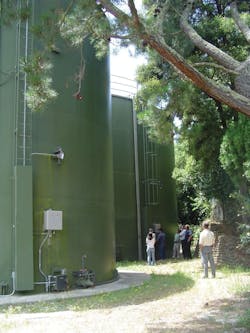Active Mixing Tames Nitrification
undefined
Redwood City, Calif., is one of 24 municipalities in the San Francisco Bay Area that receives its water from the San Francisco Public Utility Commission (SFPUC).
Several years ago, SFPUC switched to chloramination to reduce disinfection by-product (DBP) levels. Since that time, however, many municipalities receiving SFPUC water have struggled to avoid nitrification, particularly during summer months.
In summer 2005, Redwood City had several episodes of nitrification in a short period of time. Multilevel water quality sampling revealed that cool water at the bottom of the tank had plenty of disinfectant, but warm water at the top of the tank often had little or no residual, as well as elevated nitrite—a sure sign that another nitrification episode was imminent.
The city team tried several operational changes to increase tank mixing, including deep cycling the tank to increase turnover by as much as 60% and valving modifications to increase fill velocities. Neither operation had much effect on thermal stratification or nitrification. Deep cycling increased Redwood City’s energy costs during peak electrical rates and decreased water storage for fire protection.
In summer 2006, the city installed a submersible active mixer in the most problematic tank. In the first few hours, temperature measurements showed complete elimination of thermal stratification. In the days following installation, temperatures remained uniform throughout the tank, chlorine levels improved and stabilized, and nitrite readings at the top of the tank dropped to nominal levels.
For the rest of 2006, Redwood City experienced no further nitrification episodes. With water quality stabilized, water quality sampling frequency was reduced from several times each week to once a week. Because samples drawn from a tap at the base of the tank were representative of all water inside the tank, water quality measurements were easier to obtain and more reliable.
Since 2006, water quality at the problematic tank has remained under control. Chlorine residuals have remained consistent in the tank’s upper water levels and nitrite has remained at nominal levels, even during summer months.
Other Systems, Same Success
In the years since Redwood City installed a submersible active mixer, several other area municipalities also have installed mixers with similar results. Hillsborough, Calif., another SFPUC customer, installed a submersible active mixer in 2009. According to Cary Dahl, water operations supervisor, frequent tank flushing had been necessary to prevent nitrification. Installation of a submersible active mixer in the most problematic tank eliminated the need to flush, and water chemistry stabilized with no nitrification.
In addition, water treatment personnel in Calexico, Calif., discovered that active mixers eliminated nitrification problems and lowered DBP levels. Another system in Southern California was able to eliminate the need for on-site dosing of large amounts of chlorine after installing active mixers.
No Silver Bullet
Despite these success stories, active mixing can’t single-handedly eliminate nitrification risks. The magnitude of thermal stratification, tank turnover, tank geometry and size are critical factors that must be considered. Ensuring that an active mixer is powerful enough to overcome these dynamics and provide frequent turnover is key to proper equipment selection.
For example, a computational fluid dynamics study of Redwood City’s submersible mixer revealed that it produces more than 10,000 gal per minute of pumping within the tank. Passive systems that operate only during fill cycles or small volume pumping systems may not produce adequate tank turnover. Tank conditions are also critical.
Poorly maintained tank infrastructure, infiltration through roof openings, excessive sediment and deteriorated coatings increase nitrification risks. However, by combining active mixing with regular tank maintenance and prudent operational precautions, nitrification can be tamed in even the most challenging climates.
Peter S. Fiske and Jason Oppenheimer are employed by PAX Water Technologies, and Dan Heimel is employed by Water Systems Consulting. The authors can be reached at [email protected] or 866.729.6493.
To learn more about water quality solutions from PAX Water Technologies, click here.
